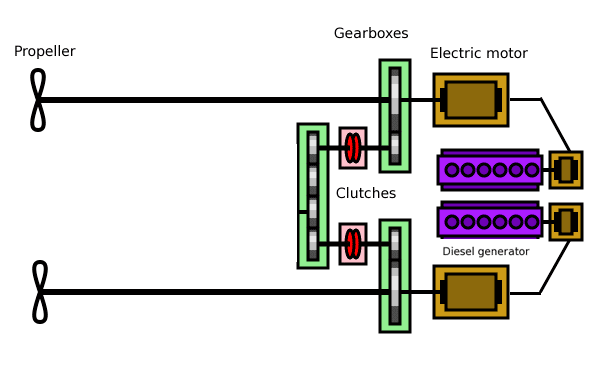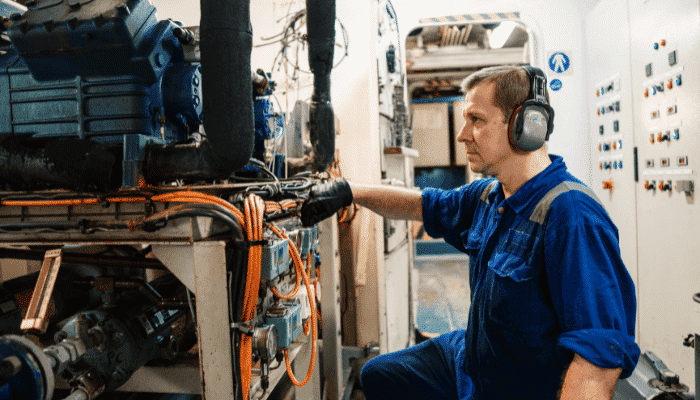Electric Propulsion System for Ship: Does it have a Future in the Shipping?
With the increase in demand for alternative propulsion systems that not only improve the overall efficiency of the ship but also reduce the carbon footprints, innovators in the shipping industry are leaving no stone unturned to find a solution to this grave problem. With all the options presently available at hand, electric propulsion system seems to have a promising future.
But as everything comes with a consequence, this system has its drawbacks too. Will or will it not make it to the engine room of every ship – this only time can tell. But what we can do is weigh its pros and cons and see if it has the vital “X” factor that everyone is talking about.
The electric propulsion system is pretty simple in merchant ship are normally characterized based on the type of prime mover attached to it. The most common types are:
Shaftline Propulsion :
As the name suggests, in this system a shaft from a prime mover is used to rotate the propeller which is connected either with reduction gear and high-speed motors or driven directly by a slow speed motor. Both asynchronous and synchronous motors are used for this purpose. The motor’s and their drive systems voltage (low or medium) will depend upon the propulsion power requirement of the ship.
Pod Propulsion:
This propulsion type is a combination of steering and propeller system. The pod propulsion unit is fitted in the place of the conventional propeller, and it comprises of an electric motor mounted inside the pod, and the propeller is directly connected to the motor shaft. The pod propeller assembly can rotate 360 degrees at its place making it easier for ships to have an ahead and astern control without needing for reversing the prime mover (here motor) or using a controllable pitch propeller. To accommodate the rotation of pod propeller, slip rings are used to supply the power from motor to the pod unit. Power is fed through a variable-frequency drive or cyclo-converter that allows speed and direction control of the propulsion motors.
The Electrical propulsion system has got a lot of advantages over the conventional engine driven propulsion system, which is obviously increasing the demand for electrical propulsion for merchant vessels. With advancement in technology and research, the electrical propulsion system is not limited to small boats and small vessels anymore.
We managed to list the main advantage of the electrical propulsion system. They are as follows:
- The system generates a significant amount of power is generated by the system and the excess power utilized by supplying it to cargo pumps, fire pumps and other important auxiliary machinery
- The space required for installation of electrical propulsion machinery is very less and compact as compared to conventional system.
- There is no direct connection of propeller shaft and prime mover, and hence transmission of severe stresses such as torsional and vibration is restricted.
- There is more flexibility in installation of machinery.
- It provides improved maneuverability and high redundancy
- Increased payload through flexible location of machinery components
- Environmental benefits from lower fuel consumption and emissions
- High performance in harsh ice conditions due to maximum torque at zero speed
- Reduces life cycle cost by less fuel consumption and maintenance cost
- Minimal standstill time for maintenance and service.
- Vessels with potential trim problems, such as stern wheelers, where machinery needs to be located forward to avoid trim problems.
- Better comfort due to reduced vibration and noise
- Much better dynamic response from zero to maximum propelling speed compared to other propulsion systems
- Less reversing time compared to other propulsion systems
- Availability of maximum torque across the entire speed range at the propeller.
- Reduced space requirements in the shaft system.
- Design and engineering of the propeller are independent of the drive.
- Flexibility in the choice of diesel engine speed.
Yes, there are disadvantages of this system as well. They are:
- The efficiency of the electrical plant is less than that of a conventional system.
- The installation cost of electrical propulsion plant is much higher.
- Different and improved training for ship’s crew as the system is completely different from mechanical system and involves major automation.
Putting advantages and disadvantages side by side, we can confidently say that the former easily surpasses the later ones. From a long term perspective, we feel that electric propulsion will not be a bad bet, keeping in mind the amount of initial investment that needs to be made, and which we think will definitely pay-off at a later stage.
Conclusion: Electrical propulsion system has already been established in the maritime industry for certain ship types (Cruise, DP etc.) and with several stringent environmental norms and regulations being included in the industry (MARPOL Annex VI, Nox, ECA’s etc. ), it certainly has a very bright future going forward.

About Author
Raunek Kantharia is a marine engineer turned maritime writer and entrepreneur. After a brief stint at the sea, he founded Marine Insight in 2010. Apart from managing Marine Insight, he also writes for a number of maritime magazines and websites.
Do you have info to share with us ? Suggest a correction
Subscribe To Our Newsletters
By subscribing, you agree to our Privacy Policy and may receive occasional deal communications; you can unsubscribe anytime.






Dear sir,
Hope this text will find you in good health. I have a query regarding speed of ships. If we want to increase speed then what parameters of motor will be changed? what are other factors due to which speed of ship can be increased ?
Hoping for a positive and swift response.
B.R,
Mussawer
There are numerous ways to read your question, so it depends on what you’re asking for.
If you’re asking for how to increase the maximum speed of the ship, then it’s a simple matter of increasing the maximum power rating of the motor.
If you’re asking how a motor increases or decreases speed then you increase or decrease the frequency of the electricity input through the variable frequency drive.
Good morning,
Why does electric propulsion increase the maneuverability of the ship?